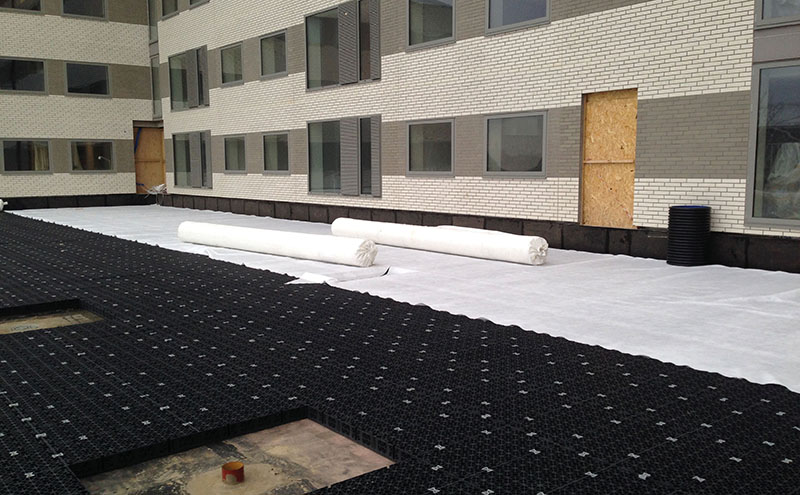
The rapid build-up of infrastructure over the past century has meant that many of our major cities have lost the ability to naturally drain stormwater. With high rise buildings, roads, and concrete paving preventing rainwater from mimicking the natural water cycle, it is imperative that town planners and architects incorporate appropriate multifunctional rainwater management solutions into their projects.
Ian Crickmore, Technical Director at Polypipe Terrain, discusses how the different methods of rainwater management, from above ground drainage solutions such as green roofs and siphonic drainage systems, can prevent our cities from going into lockdown at the first sight of rain
BY using water management and source control systems on roofs and podium decks, architects can integrate effective water management into buildings, managing the flow of rainwater out of city centres. Whilst rainwater is often stored below ground level in city centres where space is at a premium, this is often not an option. Without the expensive excavation of ground, or loss of valuable space, there is simply no room to store rainwater at ground level in urban areas.
The installation of a blue or green roof at the podium or roof level of a building can mitigate this. Green roofs are partial, or completely covered with a growing medium, planted over a waterproofing membrane, incorporating building drainage and irrigation systems. Blue and green roofs store excessive amounts of rainwater and release it at a controlled rate, preventing it from overwhelming already stressed sewer systems. This can be managed through a flow control outlet, at a rate agreed by the property developer and water companies.
The system also allows any captured rainwater to be harvested and reused within the building itself. From laundry facilities to car washing, any rainwater stored via the system can be used, saving potable water. Studies show that typically only 9% of water within commercial buildings is used for drinking water, demonstrating an increasing need to incorporate rainwater harvesting and re-use within building design.
Alongside this, green roofs facilitate the planting of seeds and local vegetation, all of which is sustained through rainwater stored in the green roof, encouraging wildlife and bio-diversity. Evidence shows us that green spaces leads to better health of city centres, regardless of socio-economic status. Designers can easily incorporate amenity areas into the projects, with the more time people spending outdoors, stress levels are reduced, an important consideration for both city planners and owners of buildings.
Where a roof level rainwater attenuation system is not possible, the specification of siphonic drainage systems can alleviate the stress excessive rainwater places on a structure. Siphonic systems provides a complete and proven way of removing large volumes of rainwater from roofs in a controlled manner. Using naturally induced siphonic principles to ‘suck’ rainwater from the roof into small diameter pipes, a flow capacity up to ten times greater than that of an equivalent gravity-fed system is created. An additional benefit of a siphonic system is that pipework is installed horizontally with no fall, giving greater freedom to the design of the system.
When conventional drainage systems use gravity to channel rainwater from the roof to the gutter, large amounts of air enters the downpipe, significantly reducing drain capacity and efficiency of the drainage system. Siphonic systems ‘suck’ water through the pipe, meaning drainage is much quicker. This in turn causes less pooling of rain on the roof, meaning less damage to the building and a reduced opportunity for leaks.
Once rainwater has landed on the roof of a building, it is transported from the gutter via downpipes. It is imperative that for effective drainage, the correct downpipe is specified. Downpipes are manufactured in different diameters. Commercial properties, in areas that experience larger amounts of rainfall, are best suited to a high capacity system. Some options, such as the Terrain Rapidflow System, can drain roof areas of up to 266m2 with a single downpipe, with a capacity per outlet of up to 5.53 litres per second, compared with some residential pipes with a capacity of 0.92 litres per second. Parts of Scotland, the Western Highlands in particular, are some of the wettest places in Europe, with annual rainfall of up to 4,577mm per year. When compared with London, which sees on average 557.4mm of rain per year, it’s clear to see why it is so important to carefully consider rainwater systems installed within a building.
The most efficient way to ensure the correct specification and installation of drainage is by using the end to end expertise of a company, such as Polypipe Terrain. From design, to product training, bespoke fabrication and installation, a holistic solution is taken into account, considering all aspects such as complicated drainage systems and expected amount of rainfall, ensuring the most suitable system for the project is installed.










